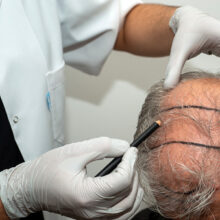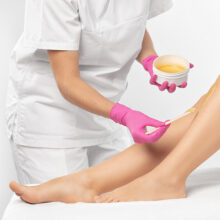Skin Care, Fitness & Healthy Eating Mistakes You’re Probably Making
- Published: Thursday, March 20th 2014
- in Beauty
 We all make mistakes (that perm I just had to have in the first grade? Seriously scorched those school pics so my fiancé never sees them. That light lipstick highlighted by dark lip liner at junior prom? At least my dress was pretty.)
We all make mistakes (that perm I just had to have in the first grade? Seriously scorched those school pics so my fiancé never sees them. That light lipstick highlighted by dark lip liner at junior prom? At least my dress was pretty.)
Like it or not, unless you’re perfect—I’m looking at you, Miranda Kerr—like me, you’re probably making your own beauty and health blunders in daily life that you may not even realize. Read on for some of the most common mistakes when it comes to skin care, fitness, and healthy eating routines—plus, how to remedy them. We may not be able to fix those perm pics (what was I thinking?), but we can certainly change these everyday blunders!
Skin Care
The mistake: “The most common mistake made in skin care is one not washing one’s face at night,” says Kim Kelder, lead esthetician and skin-care expert at Miraval Resort & Spa in Tucson, Arizona. “You would be amazed at how easy this step is, yet people still do not wash their face before hitting the sheets.” It’s not only the makeup and products you’re washing off but also the residue of the day such as pollution and free radicals, she notes.
The remedy: Kelder recommends washing your face as soon as you get home, eliminating the danger of falling asleep on the couch or snuggling up with a favorite book and getting too lazy to wash.
And, while “nothing can replace this activity…for those late nights where you don’t have the time or energy to cleanse, I recommend facial towelettes or one-step facial cleansers. Just make sure to wash extra well the following morning,” Kelder says.
The mistake: Not wearing sunscreen every day. “Did you know that 78 percent of all sun damage is caused from incidental sun exposure? This should indicate the necessity of wearing sunscreen every day, regardless of temperature,” Kelder continues.
The remedy: Look for products that have sunscreen in them such as day-time moisturizers and makeup you consistently use, Kelder suggests. Her go-to product recommendations include sunscreen-rich mineral makeup and BB and CC creams.
The mistake: Not using a night cream, which is richer and usually has more active ingredients. “I even recommend those with oily to combination skin to still hydrate at night, but with an oil-free moisturizer. Just make sure to use a cream after washing,” Kelder shares.
The remedy: Never go to bed without putting something on the skin, she tells us. “Face oils are trending now and are wonderful for dry, dehydrated and even oily skin types.”
Fitness
The mistake: “One of the biggest mistakes that people make in the fitness world is mistaking fitness and thinness for each other,” says Andrew Wolf, M. ED., R.C.E.P., exercise physiologist at Miraval. “Fitness is a performance measure: How fast can you run a mile (aerobic fitness); how much can you bench press (strength); can you perform downward dog to perfection (muscular endurance and flexibility)? These are all different ways to measure fitness, but they do not necessarily have anything to do with how you look in swimwear.”
Fitness is actually fairly easy, Wolf continues. “To be aerobically fit you could get away with two short high-intensity workouts per week. Nasty intervals done as little as twice a week will make you faster and fitter, but is not usually enough exercise to get you thinner or drop your cholesterol. The same could be said of strength and flexibility training.”
The remedy: When getting into the realm of thinness, take a good, hard look in the mirror and ask some basic questions, he goes on. For example, how comfortable am I with keeping an eye on my portions and eating intact foods for satiation? “In addition, you have to ask how much time you have/want to give to exercise,” Wolf says. “If you are in a position where 30 minutes three times per week at a comfy pace is what you can give, then you have to lean on the portion control part of the equation to see results. If you are going to quit your day job and become a full-time triathlete, portion control will not be such a big deal when it comes to changing your shape.
“Be honest with yourself and take a good, hard look at what you are really doing and make dietary changes that reflect how hard you are working when you are exercising,” he adds.
Wolf also urges clients to feed themselves post exercise. “Getting a few calories into yourself post exercise keeps you from going home, getting cleaned up, and then eating like a Viking when someone finally puts food in front of you. If eating 250 calories right after exercise is the difference between eating 500 or 1,500 calories at dinner than that little post-exercise snack was worth it!” Wolf reveals.
Healthy Eating
The mistake: “One of the biggest nutritional mistakes that I commonly see in regards to weight loss is food selection according to what nutrients food doesn’t contain, rather than what it does contain,” offers Junelle Lupiani, R.D., and on-site nutritionist at Miraval. “Albeit the undoubtable truth in terms of weight loss is to eat less and move more; however, this has led us down an unhealthy path of selecting and consuming food according to ingredients it has been stripped of.” Examples of this include “fat free”; “low fat”; “low carb”; “low calorie”; and the infamous “diet” label, Lupiani says.
The remedy: Instead of basing food choices on what foods don’t contain, base them on the nutrients and ingredients they do contain, she suggests. “In other words, consider the nutritional worth of your food. By coming at it from this direction, people begin to see that bananas really aren’t the reason they are struggling with their weight, and the sugar content of carrots and grapes are likely not the issue.
“Transcend beyond the diet mentality. Redirect yourself—stop thinking about healthy eating based on what it doesn’t contain, but what it does contain!” Lupiani concludes.
![giftcard_ad[1]](https://cdn.spafinder.com/giftcard_ad1.jpg)



